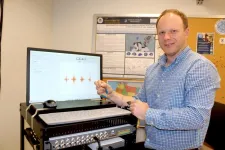(Press-News.org) Every year, about 800,000 new stroke cases are reported in the United States, often causing patients problems with both neurological and physical motor control. Disruptions in the mobility of the arms and hands, in particular, can have devastating impacts on stroke patients’ quality of life.
The restoration of arm extremity and hand dexterity are often the highest priority among stroke patients. A new robotic platform developed at the University of Rhode Island, which utilizes both a patient’s brainwaves and muscle activity, aims to help post-stroke patients perform needed rehabilitation and regain critical motor skills, including complex tasks like reaching and grasping for an object.
Mariusz Furmanek, assistant professor of physical therapy and PI of the URI Motor Control and Rehabilitation Lab, is working with engineering professors Reza Abiri and Yalda Shahriari on the assistive planar robot, which includes a cutting-edge closed-loop feedback system to monitor the muscle and brain activity of the user in order to trigger the execution of reach and grab in an adaptive way.
“Numerous rehabilitation approaches such as muscular electrical stimulations, brain-computer interfaces, and transcranial magnetic stimulation have been investigated to assist the affected individuals. Only sparse research has been conducted to show the efficacy of assistive planar robots in offering affordable independent solutions to address this demand,” the researchers write in a study summary, which is supported by a $460,000 award from the National Science Foundation’s Disability and Rehabilitation Engineering program. “Designing and developing such robots with satisfactory rehabilitative outcomes could be crucial for high demand tasks such as repetitive motor training as intervention in the early stage of stroke.”
The project, which aims to make significant strides in rehabilitation methodologies, will advance the rehabilitation of upper-extremity motor functions for post-stroke patients. User-generated feedback will tailor the device to each user. The use for post-stroke patients could be immediate. Users will be able to more quickly recover neural plasticity, improving their brain capacity to continue growing and evolving, adapting and changing through the creation of new neurons and networks. The user-centered robotic device can also provide occupational therapy in the patient’s own home. Having a device at home, outside of the clinical setting, would mean more integration into daily life and more physical therapy for patients.
“Through cutting-edge technology, we envision a transformative impact on the rehabilitation journey for post-stroke individuals,” Furmanek said. “The project focuses on developing a user-friendly wearable exoskeleton for adaptive assistance. Through a portable robotic training platform, we aim to overcome barriers, accelerate recovery, and advance the understanding of poststroke upper arm extremity rehabilitation.”
The researchers are also working with and consulting with stroke specialist and Massachusetts General Hospital neurologist David Lin. In the future, the technology could be used for patients with other categories or neurological diseases.
“Despite technological advancements, the intricate nature of the brain poses a significant challenge,” Furmanek said. “Neuroscience remains one of the frontiers due to numerous fundamental questions that await answers.”
END
Robotic rehab aims to help stroke patients regain hand dexterity
Research in University of Rhode Island Motor Control and Rehabilitation lab funded by $460,000 grant from National Science Foundation
2024-01-08
ELSE PRESS RELEASES FROM THIS DATE:
Illinois Tech launches sensor technology program with emphasis on veteran education
2024-01-08
CHICAGO—January 8, 2023—Illinois Institute of Technology (Illinois Tech) has received a substantial grant from the National Science Foundation (NSF) to launch a pioneering education program in sensory technology aimed at underrepresented groups—particularly veterans. The initiative, funded through NSF’s Experiential Learning for Emerging and Novel Technologies (ExLENT) program, underscores Illinois Tech’s commitment to critical future technologies and expanding education to groups that have historically ...
Study highlights barriers to contraceptive access for disabled Medicare enrollees
2024-01-08
PITTSBURGH — Contraceptive use is low among reproductive-aged people with disabilities who are enrolled in Medicare, according to a new study from the University of Pittsburgh that highlights how lack of contraceptive coverage by Medicare may prevent disabled enrollees from accessing contraception.
Published today in the January issue of Health Affairs, the study provides the first national overview of contraceptive use among enrollees in Medicare, the government health insurance for people over 65 and for people with qualifying disabilities. ...
Study of national data demonstrates the value of acute hospital care at home
2024-01-08
Since the Centers for Medicare and Medicaid Services launched the Acute Hospital Care at Home (AHCaH) Waiver in 2020, thousands of patients from across 300 hospitals in 37 states have been treated in their homes. Yet little is understood about these patients’ outcomes on a national level, and the waiver will end in December 2024 unless there is an act from Congress. A new study by investigators from Mass General Brigham analyzed outcomes from AHCaH for a diverse group of patients across America. The study provides preliminary evidence suggesting that home hospital ...
Hospital care at home benefits medically complex, socially vulnerable patients
2024-01-08
Embargoed for release until 5:00 p.m. ET on Monday 8 January 2024
Annals of Internal Medicine Tip Sheet
@Annalsofim
Below please find summaries of new articles that will be published in the next issue of Annals of Internal Medicine. The summaries are not intended to substitute for the full articles as a source of information. This information is under strict embargo and by taking it into possession, media representatives are committing to the terms of the embargo not only on their ...
Real-world analysis: COVID-19 vaccine strongly effective for children and adolescents during delta and omicron
2024-01-08
Children and adolescents who received one of the main COVID-19 vaccines were significantly protected from the illness and showed no increased signs of cardiac complications compared to young people who were not vaccinated, according to a new real-world study led by researchers from the Perelman School of Medicine at the University of Pennsylvania and Children’s Hospital of Philadelphia (CHOP). When the Delta variant rose to prominence, the study showed that vaccinated young people were 98 percent less likely to be infected than their unvaccinated peers, and ...
Studying cells to improve medulloblastoma treatment
2024-01-08
Research is shedding light and potentially expanding options for patients living with Medulloblastoma, an aggressive childhood cancer.
Medulloblastoma is a cancer impacting both very young and school aged children.
When children get this type of brain tumor, they experience the process of the tumor blocking flow of fluid around the brain.
This can cause severe headaches, vomiting, sleepiness, fussiness, and difficulty walking and coordinating movements.
Treatment is intense, involving high dose chemotherapy, surgery, and sometimes radiation or stem cell transplants.
During these months long treatments, children may lose ...
Residential addiction treatment for U.S. teens is scarce, expensive
2024-01-08
Despite an alarming increase in overdose deaths among young people nationwide, a new “secret shopper”-style study led by Oregon Health & Science University researchers finds that access to residential addiction treatment centers for adolescents in the United States is limited and costly.
The study, published today in the January issue of the journal Health Affairs, found that about half of the sites reported a wait time, and among those the average wait was almost a month. For those who do manage to find a placement, the average daily cost is $878 — with close to half of the facilities that provided information requiring partial or full payment upfront. For the average ...
Residential addiction treatment for adolescents is scarce and expensive
2024-01-08
Access to residential addiction treatment centers caring for U.S. adolescents under 18 years old in the United States is limited and costly, according to a new study supported by the National Institutes of Health. Researchers found that only about half (54%) of the residential addiction treatment facilities that they contacted had a bed immediately available, and for those that had a waitlist, the average estimated time before a bed opened was 28 days. In addition, the average daily cost per day of treatment was $878, with close to half (48%) of the facilities that provided information requiring partial or full payment upfront. ...
Transformation-associated recombination (TAR) cloning and its applications
2024-01-08
“TAR cloning is used to genetically engineer synthetic viruses with novel properties that may be used for the development of new vaccines.”
BUFFALO, NY- January 8, 2024 – A new review paper was published in Oncotarget's Volume 14 on December 22, 2023, entitled, “Transformation-associated recombination (TAR) cloning and its applications for gene function; genome architecture and evolution; biotechnology and biomedicine.”
Transformation-associated recombination (TAR) cloning represents a unique tool to selectively and efficiently recover a given chromosomal segment up to several hundred ...
Slow the scroll: Users less vigilant about misinformation on mobile phones
2024-01-08
UNIVERSITY PARK, Pa. — Mobile phones pack a lot of information into pocket-sized devices, which is why users may want to slow down the next time they’re scrolling through social media or checking email on a mobile app. People process information more efficiently but tend to be less vigilant about misinformation on their mobile phones compared to personal computers (PCs), according to a team led by Penn State researchers. This is especially true for users who have developed a routine or habit of using their ...
LAST 30 PRESS RELEASES:
Bacteria resisting viral infection can still sink carbon to ocean floor
Younger biological age may increase depression risk in older women during COVID-19
Bharat Innovates 2026 National Basecamp Showcases India’s Most Promising Deep-Tech Ventures
Here’s what determines whether your income level rises or falls
SCIE indexation achievement: Celebrate with Space: Science & Technology
Children’s Hospital Colorado performs region’s first pediatric heart and liver dual organ transplant
Australian team discover why quantum computers have memory problems over time
What determines the fate of a T cell?
Candida auris: genetic process revealed which could be treatment target for deadly fungal disease
Groundbreaking discovery turns household plastic recycling into anti-cancer medication
Blocking a key inflammatory pathway improves liver structure and vascular function in cirrhosis, study finds
Continuous spread: Raccoon roundworm detected in nine European countries
HKUST Engineering researchers developed a novel photodetector to enhance the performance of on-chip light monitoring
Strategic river sensors could have forewarned of Texas Camp flood disaster
Drone sampling of whale breath reveals first evidence of potentially deadly virus in Arctic
Roman soldiers defending Hadrian’s Wall infected by parasites, study finds
Pinochet’s prisoners were tormented with music but still found solace in it, a new book reveals
Fertility remains high in rural Tanzania despite access to family planning
AI-assisted device can improve autism care access
Kinetic careers
Uncovering how parasitic plants avoid attacking themselves to improve crop resistance
Nanoparticle vaccine strategy could protect against Ebola and other deadly filoviruses
Study finds brain care score can predict risk of stroke across racial groups
Key lung immune cells can intensify allergic reactions
Do hormones explain why women experience more gut pain?
New materials conduct ions in solids as easily as in liquids
Breakthrough of the Year: Renewable energy begins to eclipse fossil fuel-based sources
LLM use is reshaping scientific enterprise by increasing output, reducing quality and more
Introducing LightGen, a chip for ultra-fast, ultra-efficient generative AI
Astronomers see fireworks from violent collisions around nearby star
[Press-News.org] Robotic rehab aims to help stroke patients regain hand dexterityResearch in University of Rhode Island Motor Control and Rehabilitation lab funded by $460,000 grant from National Science Foundation



